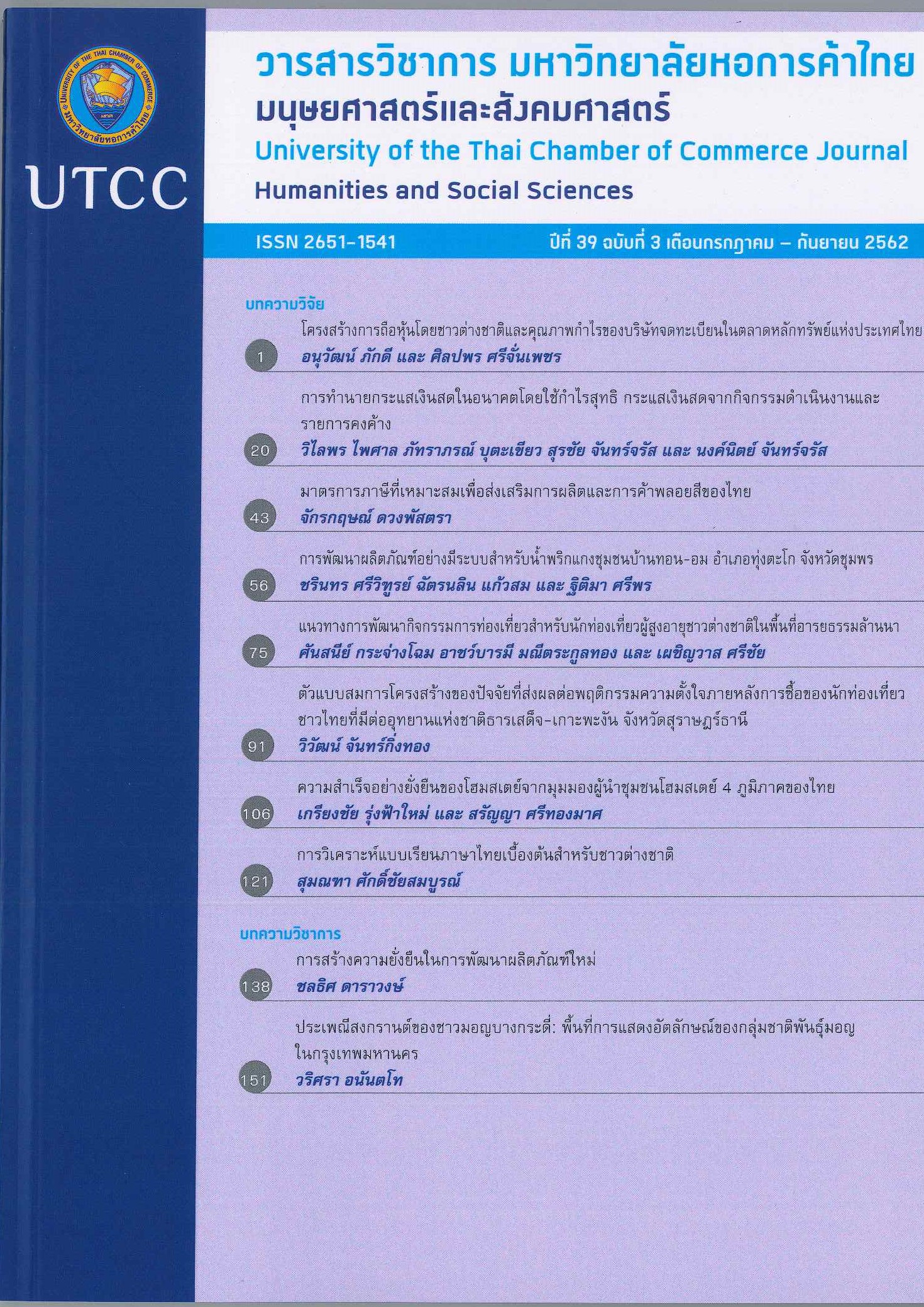Structural Equation Model of Factors Affecting Thai Tourist Post-purchase Behavioral Intentions toward Than Sadet-Ko Pha-Ngan National Park Suratthani Province
Main Article Content
Abstract
The purpose of this study was to test a structural equation model of factors affecting tourist post-purchase behavioral intentions toward Than Sadet-Ko Pha-Ngan National park. The sample of the study was 400 Thai tourists who visited Than Sadet-Ko Pha-Ngan National park by using accidental sampling. Research hypothesis included five major factors causing tourist post-purchase behavioral intentions with latent variables: corporate social responsibility, destination image, perceived value, tourist satisfaction and tourist complaints. Data were collected by requesting the sample group to answer questionnaires. Lisrel 8.8 Program was employed to test the specified structural equation model. The results revealed that the model was consistent with empirical data at a good level. Meanwhile, perceived value, tourist satisfaction and tourist complaints directly affect tourist post-purchase behavioral intentions, whereas the indirect factors affecting tourist post-purchase behavioral intentions include corporate social responsibility, destination image, perceived value and tourist satisfaction.
Article Details
ลิขสิทธิ์ของบทความ
ผลงานที่ได้รับการตีพิมพ์ถือเป็นลิขสิทธิ์ของมหาวิทยาลัยหอการค้าไทย ห้ามมิให้นำเนื้อหา ทัศนะ หรือข้อคิดเห็นใด ๆ ของผลงานไปทำซ้ำ ดัดแปลง หรือเผยแพร่ ไม่ว่าทั้งหมดหรือบางส่วนโดยไม่ได้รับอนุญาตเป็นลายลักษณ์อักษรจากมหาวิทยาลัยหอการค้าไทยก่อน
References
การท่องเที่ยวแห่งประเทศไทย. (2559). ข้อมูลอุทยานแห่งชาติธารเสด็จ-เกาะพะงัน. สืบค้นเมื่อ 4 ธันวาคม 2559, จาก http://thai.tourismthailand.org
วิวัฒน์ จันทร์กิ่งทอง. (2556). ตัวแบบสมการโครงสร้างของปัจจัยที่ส่งผลต่อความภักดีของนักท่องเที่ยวชาวไทยที่มีต่อุทยานแห่งชาติทางทะเลในภาคใต้ของประเทศไทย. วารสารวิชาการมหาวิทยาลัยหอการค้าไทย, 33(3 ), 1-15.
วิวัฒน์ จันทร์กิ่งทอง. (2558ก). ปัจจัยเหตุและผลของความพึงพอใจของนักท่องเที่ยวชาวไทยในอุทยานแห่งชาติ เขาปู่-เขาย่า จังหวัดพัทลุง. วารสารวิชาการมหาวิทยาลัยหอการค้าไทย, 35(2), 59-72.
วิวัฒน์ จันทร์กิ่งทอง. (2558ข).ตัวแบบสมการโครงสร้างของปัจจัยที่ส่งผลต่อความภักดีของนักท่องเที่ยวชาวไทยที่มีอุทยานแห่งชาติทางบกในภาคใต้ของประเทศไทย.วารสารมหาวิทยาศิลปากร, 35(2), 1-18.
Caruana, A. (2002). Service loyalty: The effects of service quality and the mediating role of customer satisfaction. European Journal of Marketing, 36(7/8), 811-828.
Çoban, S. (2012). The effects of the image of destination on tourist satisfaction and loyalty: The case of Cappadocia. European Journal of Social Sciences, 29(2), 222-232.
Cunningham, R. M. (1956). Brand loyalty-what, where, how much?. Harvard Business Review, 34(1), 116-128.
Fishbein, M., & Ajzen, I. (2010). Predicting and changing behavior: The reasoned action approach. New York, NY: Psychology Press.
He, H., & Li, Y. (2011). CSR and service brand: The mediating effect of brand identification and moderating effect of service quality. Journal of Business Ethics, 100(4), 673-688.
Kim, S. H., Holland, S., & Han, H. S. (2013). A structural model for examining how destination image, perceived value, and service quality affect destination loyalty: a case study of Orlando. International Journal of Tourism Research, 15(4), 313-328.
Kline, R. B. (2011). Principles and practice of structural equation modeling (3rd ed.). New York, NY: Guilford Press.
Kozak, M., & Decrop, A. (2009). Handbook of tourist behavior: Theory & practice. New York, NY: Routledge.
Lee, S., Jeon, S., & Kim, D. (2011). The impact of tour quality and tourist satisfaction on tourist loyalty: The case of Chinese tourists in Korea. Tourism Management, 32(5), 1115-1124.
Loureiro, S. M. C., & Gonzalez, F. J. M. (2008). The importance of quality, satisfaction, trust, and image in relation to rural tourist loyalty. Journal of Travel and Tourism Marketing, 25(2), 117-136.
Maghsoodi Tilaki, M. J., Hedayati Marzbali, M., Abdullah, A., & Bahauddin, A. (2016). Examining the influence of international tourists’ destination image and satisfaction on their behavioral intention in Penang, Malaysia. Journal of Quality Assurance in Hospitality & Tourism, 17(4), 425-452.
Martin, J. D., Petty, J. W., & Wallace, J. S. (2009). Value-based management with corporate social responsibility (2nd ed.). Oxford, England: Oxford University Press.
Pandža Bajs, I. (2015). Tourist perceived value, relationship to satisfaction, and behavioral intentions: The example of the Croatian tourist destination Dubrovnik. Journal of Travel Research, 54(1), 122-134.
Robinson, S., & Etherington, L. (2006). Customer loyalty: A guide for time travelers. New York, NY: Palgrave Macmillan.
Stan, V. (2015). Does consumer gender influence the relationship between consumer loyalty and its antecedents?. Journal of Applied Business Research, 31, 1596-1604.
Stanaland, A., Lwin, M., & Murphy, P. (2011). Consumer perceptions of the antecedents and consequences of corporate social responsibility. Journal of Business Ethics, 102(1), 47-55.
Velázquez, B. M., Saura, I. G., and Molina, M. E. R. (2011). Conceptualizing and measuring loyalty: Towards a conceptual model of tourist loyalty antecedents. Journal of Vacation Marketing, 17(1), 65-81.
Wang, C. Y., & Hsu, M. K. (2010). The relationships of destination image, satisfaction, and behavioral intentions: An integrated model. Journal of Travel and Tourism Marketing, 27(8), 829-843.
Wang, X., Zhang, J., Gu, C., and Zhen, F. (2009). Examining antecedents and consequences of tourist satisfaction: A structural modeling approach. Tsinghua Science and Technology, 14(3), 397- 406.
Yamane, T. (1973). Statistics: An introductory analysis (3 rd ed.). New York, NY: Harper and Row.

